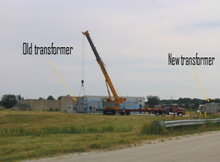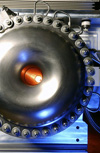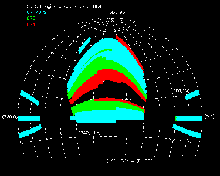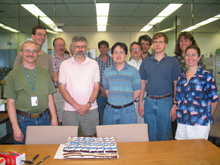 | Wednesday, July 6, 2005 |
|
Wednesday, July 6 THERE WILL BE NO FERMILAB ILC R&D MEETING THIS WEEK 1:00 p.m. Seminar - WH10NW (The West Wing) Title: Search for coherent charged pion production in neutrino-carbon interactions with the K2K SciBar detector Speaker: Masashi Yokoyama (Kyoto) 3:30 p.m. DIRECTOR'S COFFEE BREAK - 2nd Flr X-Over 4:00 p.m. Fermilab Colloquium - 1 West Speaker: J. Turner, National Renewable Energy Laboratory Title: The Sustainable Hydrogen Economy
Thursday, July 7 |
|
Extended Forecast |
Secon Level 3 |
|
Wednesday, July 6 Italian Wedding with Meatballs Diner Style Patty Melt $4.85 Chicken a la Mer $3.75 Beef & Broc $3.75 Greek Chicken Panini with Feta Cheese $4.85 Sicilian Style Pizza $3.00 Grilled Chicken Bowtie in a Tomato Cream Sauce $4.85 The Wilson Hall Cafe now accepts Visa, Master Card, Discover and American Express at Cash Register #1.
Wilson Hall Cafe Menu |
| Fermilab Today is online at: http://www.fnal.gov/today/ Send comments and suggestions to today@fnal.gov Fermilab Today archive Fermilab Today PDF Version Fermilab Result of the Week archive Fermilab Safety Tip of the Week archive Linear Collider News archive Fermilab Today classifieds Subscribe/Unsubscribe to |
|
Repair Crews Rise to the
Occasion: Power Restored | ||
| ||
|
Over the long holiday weekend, nine employees from the EE Support Department
and the Mechanical Support Department were called away from their barbeques
and family gatherings to help repair a transformer outside the MI 20 Service
Building. The transformer had to be disconnected and lifted out using a
T&M rigging crew before it was replaced with a spare. "Other than the down
time necessary to replace the transformer," said Dan Wolff of the EE Support
Department, "there should be no short- or long-term effects on accelerator
operations."
A transformer failure is by no means a frequent occurrence at the lab, but it is not unknown either. "I would estimate that we get some sort of transformer failure here at Fermilab every three or four years," said Wolff. The emergency crew was well-prepared, and handled the situation quickly and safely. The transformer failed late Saturday evening and all power was restored by early Tuesday morning when the rest of the lab returned from the July 4th break.
"The success of the lab's 24-hour-a-day operation depends so much on individuals
like these who are willing to give up family time and weekend activities to
ensure that repairs are made and the machine is back up and running in a timely
fashion," said Wolff. "One only has to read the E-log to see how many of our
people rise to this challenge on a regular basis."
|
|
FNAL Hosts International NBI Workshop July 7-11 Fermilab, URA and the University of Texas at Austin will co-host the 2005 International Workshop on Neutrino Beams and Instrumentation (NBI2005) beginning tomorrow. Physicists and engineers from around the world will meet through Monday, July 11 to discuss their current and planned projects for conventional neutrino beams. Representatives from Neutrinos at the Main Injector (NuMI) and MiniBooNE (Fermilab), the Cern to Gran Sasso (CNGS) Project (CERN), KEK-to-Kamioka (K2K) Project (KEK), Brookhaven Neutrino Beam Proposal, and the Tokai-to-Kamioka (T2K) Project at the Japanese Proton Accelerator Research Project will focus talks
The workshop has drawn about 65 registrants. "This is our biggest attendance yet," said organizing committee co-chair Sacha Kopp of MINOS and the University of Texas. "We have lots of new exciting results from NuMI and MiniBooNE to discuss."
The program includes sessions on primary beam delivery systems, high-power
target design, focusing horns, secondary beam instrumentation, beam Monte
Carlo techniques, and radiation shielding and protection. Kopp emphasizes
that "everyone is welcome," and a full schedule is available at the
conference website.
|
|
July 1 - July 4 - During this 72 hour period operations established one store that provide the experiments with approximately 29 hours and 46 minutes of luminosity - Linac switched to I- Source - KRF7 tripped off - MI transformer ground fault
Read the Current Accelerator Update |
|
From the New York Times, July 5, 2005 How Quantum Physics Can Teach Biologists About Evolution In the fall of 1900, a young German physicist, Max Planck, began making calculations about the glow emitted by objects heated to high temperature. In retrospect, it seems like a small-bore problem, just the task to give a young scientist at the beginning of his career.
But if the question sounds minor, Planck's answer was not. His work led him to discover a new world, the bizarre realm of quantum mechanics, where matter is both a particle and a wave and where the predictable stability of Newton gives way to probabilistic uncertainty.
|
|
SDSS Makes Fourth Data Release, Receives Full Funding for SDSS-II | ||
| ||
|
The Sloan Digital Sky Survey celebrated two milestones last week: On
Wednesday, the fourth major public data release (DR4) was made
available online.
On the same day, SDSS director Richard Kron received
an award letter from the National Science Foundation, which confirmed
full funding for the requested NSF portion of a three-year extension
to the SDSS.
With DR4, the SDSS is enabling the scientific and the general public to access 12 Terabytes of astronomical data - both images and object catalogs. Fermilab is hosting the data distribution servers, which include both a Linux disk archive of image and table data, and a cluster of Microsoft Windows machines hosting a Microsoft SQL Server, database which allows astronomeres to run sophisticated queries. "Even though it's already our fourth major release, it's a new challenge every time, both because of the rapidly increasing data volume and because we keep adding new features and data products to the archive servers," explains SDSS project manager Bill Boroski. "Everyone in the data distribution team here at Fermilab and at Johns Hopkins University, together with scientists throughout the SDSS collaboration, really pulled together to make it happen on time." SDSS-II is a three-year extension to the SDSS, whose original funding expired on June 30. The extension continues to use the SDSS 2.5m telescope at Apache Point, NM, for which Fermilab is in the process of upgrading the data acquistion system. There are three science programs in SDSS-II: the "SDSS Legacy" will complete spectroscopy of galaxies and quasars over an enormous contiguous area of roughly 8000 square degrees. The SDSS Supernova Survey will repeatedly observe a 200 square degree patch of sky to discover exploding stars. Measuring the distances to these distant supernovae will constrain the expansion rate of the universe, thus teaching us about the properties of the mysterious "dark energy" that speeds up the expansion of the universe. Finally, the SEGUE program will measure the positions and velocities of stars in the Milky Way in order to infer the distribution of dark matter and the formation history of the Galaxy. The NSF award letter completed the funding requirements for SDSS-II, which had already received the support of the Sloan foundation and of old and new participating institutions in the project, including Fermilab. | ||
|
Result of the Week Archive |
|
Fermi Days at Great America in July - $25 Tickets Enjoy a day at Great America for only $25.00. The Recreation Office has designated July 9, 10, 23 & 24 as Fermi Days at Great America. Purchase tickets in the Recreation Office for only $25.00 and enjoy one of these days at Great America with your friends and family. Tickets can be purchased in the Recreation Office.
International Folk Dancing |



